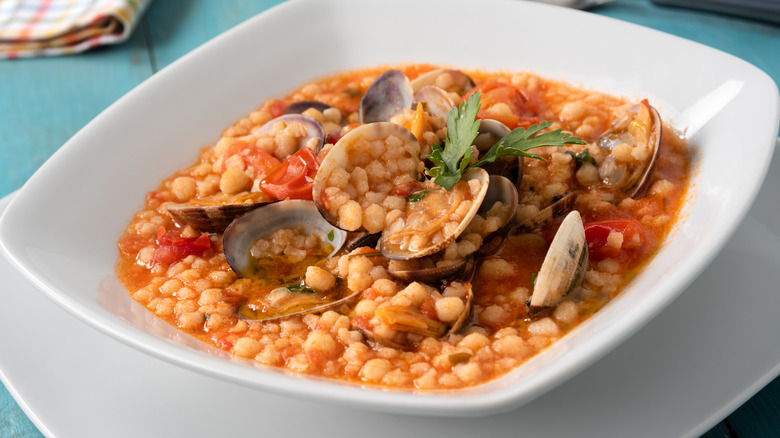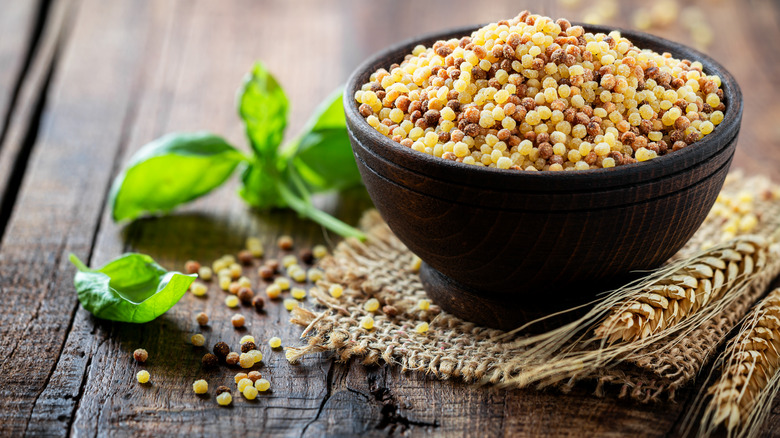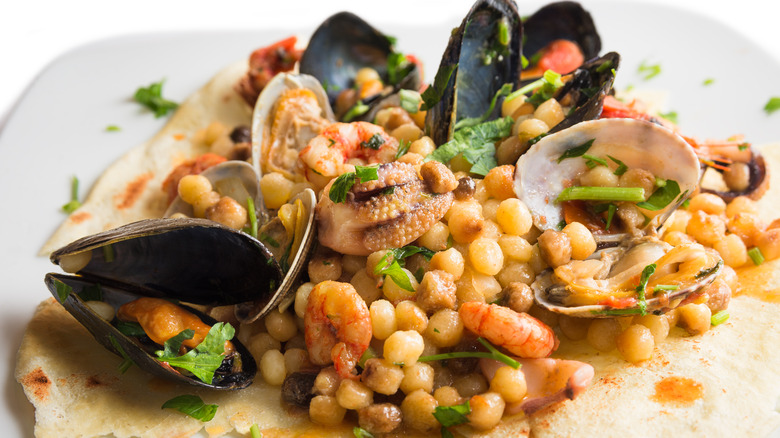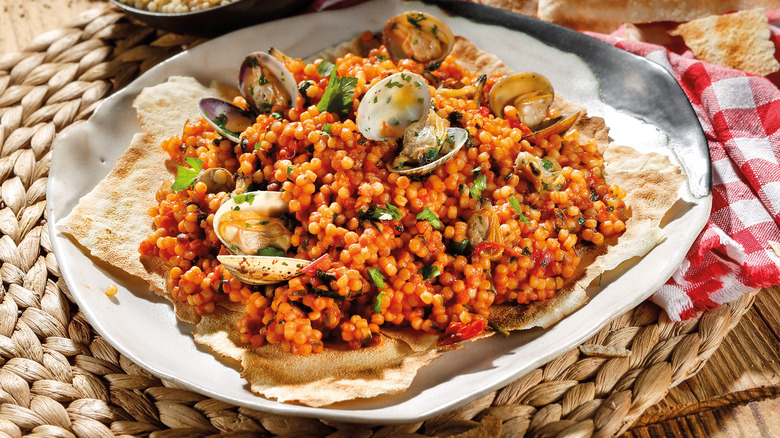Sardinia's Fregola Is The Pasta-Grain Hybrid Similar To Couscous
From hollow manicotti to flat lasagna, pasta comes in many forms. It's no surprise, as the beloved food encompasses a wide variety of regional specialties. On the Italian island of Sardinia, the local variation is called fregola. This small, grain-shaped pasta is simple in the constituency, made from only durum wheat semolina and water. However, its savory, nutty flavor, bolstered by a chewy texture, makes it extraordinarily complex. Plus, fregola can be used in a wide range of culinary applications. The pasta can be incorporated into stews and salads or served as a standalone dish.
Visually, the pasta looks similar to couscous, especially the variant popular in Israel. However, its flour base, combined with the production process and toasted flavor, is distinct. Considering its heritage, it makes sense there's nothing quite like it — the pasta type has been crafted in Sardinia since the 10th century. Let's dive into how fregola is produced.
How is fregola made?
Fregola is made from durum semolina wheat and water. Often still manufactured traditionally, the pasta requires a technique-intensive approach utilizing wooden or terracotta bowls. The semolina flour is sprinkled onto the surface, and then a precise ratio of water is poured on top. Using fingertips, the clay-like mixture is massaged to form small pellets. These balls are then air-dried on a specific cloth in Sardinia's hot, sunny climate.
Although it won't have the same characteristics as traditional Sardinan fregola, the pasta can also be made using a food processor. Water is slowly introduced to semolina flour spinning in the device until it starts to lump together. The pellets are then baked in an oven to harden.
Regardless of the preparation method, the toasting of fregola differentiates it from couscous and other pasta varieties. The step imparts a savory flavor, as well as a distinct chewy texture. And since the pasta contains exclusively wheat and water, toasting hardens for a longer shelf life. In a cool, dark place, fregola will remain edible for up to two years.
How to cook with fregola
Fregola can be prepared with two different methods — boiled and drained like other types of pasta or simmered and infused with stock like a risotto. Regardless of the heat application, the pasta requires a longer cooking time, up to 15 minutes of simmering. When cooked in a flavored liquid, it'll infuse more flavor but be less chewy. However, cooked separately, it'll have a more distinct texture that necessitates a bolder flavor.
When it comes to flavor pairings, fregola is malleable to many possibilities. Classic Sardinian renditions include pasta made with sausage and garnished with aromatic herbs like parsley, basil, and wild fennel. It's also commonly used as a vessel for seafood, infused with a pleasantly salty tomato sauce, and served alongside shrimp, calamari, and mussels.
However, fregola is also fit to a range of other influences outside Sardinia. It can be a filler in a nourishing chicken soup or the base of a cold pasta similar to an Israeli couscous salad. With its unusual flavor, it'll substitute especially well into whole wheat pasta recipes.
How fregola compares to couscous
Given fregola's constituency and shape, it's not surprising many confuse it with couscous. In fact, some believe fregola was introduced to Sardinia from Northern Africa, meaning it could be a derivation of couscous.
However, there are some distinct characteristics that distinguish the two types. Firstly, fregola is made from milled semolina rather than crushed — which makes it more similar to other Italian pasta. Additionally, it's larger in size and toasted, and these are characteristics that lend it a chewier, denser texture than softer varieties of couscous. Fregola is most similar to Israeli couscous rather than North African varieties.
Fregola differs in preparation method, too. Unlike couscous, it's not steamed and instead boiled. And it requires a longer cooking time as opposed to other couscous types. Nevertheless, its robust texture allows for a greater range of incorporation into dishes like soup. So buy a batch and store it in the pantry; this Sardinian pasta is a tasty staple to keep around.



